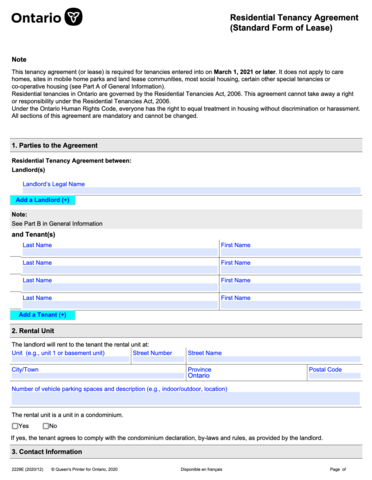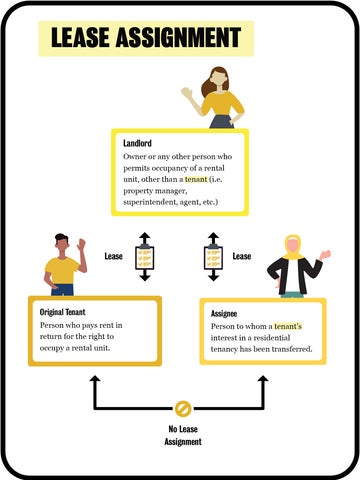
What is a lease?
A lease is a binding contract granting use or occupation of property during a specified period in exchange for a specified rent. Typically, a lease is one year in length.
Starting April 30, 2018, landlords of most private residential rental units – from individual landlords to property management companies – must use the standard lease template for all new leases.
Landlord and tenant rights and responsibilities remain the same under the Residential Tenancies Act, 2006 (RTA).
Download a copy of the standardized lease agreement.
For more information, visit the Government of Ontario, Ministry of Municipal affairs and housing. The Region of Waterloo Tip Sheet also explains what to look for in a lease or rental agreement.

Questions to ask before signing a lease
To ensure you make an informed decision about your rental housing, it’s essential to ask landlords important questions. Here’s a comprehensive list to guide your discussion:
Here are some additional resources that outline your tenant rights and responsibilities:
-
-
Subletting: Due to the co-op work terms outside of the region, subletting is common for Waterloo students. You should be aware of the legal issues with subletting that are part of the Residential Tenancies Act. Students should be aware that as the tenant, you are able to sublet your accommodation with the consent of the landlord. The landlord should be reasonable when offering consent. If you choose to sublet your space, you remain responsible for the lease. This can put students in difficult situations if the subtenant does not follow the obligations of the lease. When signing a lease, consider your plans for your work term whenever possible.
-
Note: If you are living with your landlord or their immediate family member, you are in a boarding agreement. You are not protected under the Residential Tenancies Act.
-
-
Rental scams
-
Verify the property on google and consider asking your landlord for proof of ownership
-
Don’t provide any payment before signing your lease
-
TIP: In Ontario landlords may only ask for an advance deposit of one month's rent to be applied as last month's rent and a refundable key deposit (this is the amount it would cost to replace the key). It is not legal to ask for cleaning fees, application fees, security deposits, damage deposits, holding fees. This is for all agreements covered under RTA.
-
-
Do your research on neighborhoods and what the average cost in the area is. Keep your guard up and use common sense.
-
Check the place out even if it’s a virtual live viewing
-
See this infographic from Advocacy Centre for Tenants Ontario outlining scams to learn how to spot the most common scams
-
If you are concerned that a listing may be a scam, this "how to spot a rental scam" resource has tips to help you identify if it is safe.
-
The difference between Subtenancy and a Lease Assignment
Subtenancy

Lease Assignment

|
Subtenancy |
Lease Assignment |
|
|
Contract |
Lease between the original tenant (referred to as the “head tenant”) and the subtenant (referred to as the “new tenant”) |
The original tenant transfers their lease to the assignee (referred to as “new tenant”). The terms of the original tenancy agreement apply. |
|
Conditions for a valid contract |
Four conditions must be fulfilled: 1) The original tenant must vacate the rental unit; • If the original tenant does not vacate the rental unit but allows another person to live in the rental unit, the other person is considered a roommate and/or an occupant of the rental unit. 2) The term of the Subtenancy Agreement must end on a specified date before the end of the original tenant’s lease; • It is possible to create a subtenancy for one month less one day in the case of a month-to-month tenancy. 3) The original tenant retains the right to resume occupancy of the rental unit at the end of the subtenancy; and 4) The original tenant must obtain the landlord’s consent. • The landlord shall not arbitrarily or unreasonably withhold consent. If this happens, the original tenant may apply to the LTB. • If no consent is obtained, the landlord may apply to the LTB for an order terminating the subtenancy and evicting the “subtenant” who is in fact an “unauthorized occupant.” |
One condition must be fulfilled: 1) The original tenant must seek the landlord’s consent to the assignment, either general (i.e. “Okay, you can assign your lease to someone”) or specific (i.e. “Okay, you can assign your lease to Jane Doe”). • Where a landlord refuses to consent to a general assignment, or does not respond within seven days, the tenant may give the landlord a notice of termination within thirty days after the date the tenant requested consent to an assignment or apply to the LTB. • Where a landlord has consented to an assignment in principle (i.e. no paperwork signed), the original tenant must still obtain the landlord’s further consent to an assignment to a specific assignee. In that case, the landlord may determine if the potential assignee is an appropriate tenant. |
|
Period of time |
Fixed period; less than the term of the head tenant’s lease |
For the remainder of the original lease, as per the terms and conditions agreed upon by the original tenant. When the term expires, it becomes a month-to-month lease. |
|
Original tenant’s rights and obligations |
The original tenant is still liable to the landlord as if still living there; the contractual relationship remains. The original tenant also has a contractual relationship with the subtenant. Certain provisions of the RTA apply, such as arrears of rent, damage to rental unit, interference with enjoyment, etc. |
The original tenant will only be liable for breaches and obligations related to the period prior to the assignment. There are no ongoing obligations on the part of the original tenant once the lease has been transferred. |
|
New tenant’s rights and obligations |
The subtenant is not liable towards the landlord, as there is NO contractual relationship between them. They are only liable toward the original tenant. The subtenant’s rights are limited to section 135 of the RTA (i.e. money collected illegally). For any other matters, the subtenant must turn to the original tenant for relief, who in turn may enforce obligations against the landlord. |
The assignee is liable toward the landlord, not toward the original tenant, as there is no contractual relationship between the assignee and the original tenant. The assignee steps into the shoes of the original tenant in all respects, and thus is covered by all the protections provided by the RTA |
|
Fees and costs |
The landlord may only charge reasonable out-of-pocket expenses incurred in giving consent to subtenancy. |
The landlord may only charge reasonable out-of-pocket expenses incurred in giving consent to assignment (e.g. credit check), and may not be compensated for internal administrative steps. |